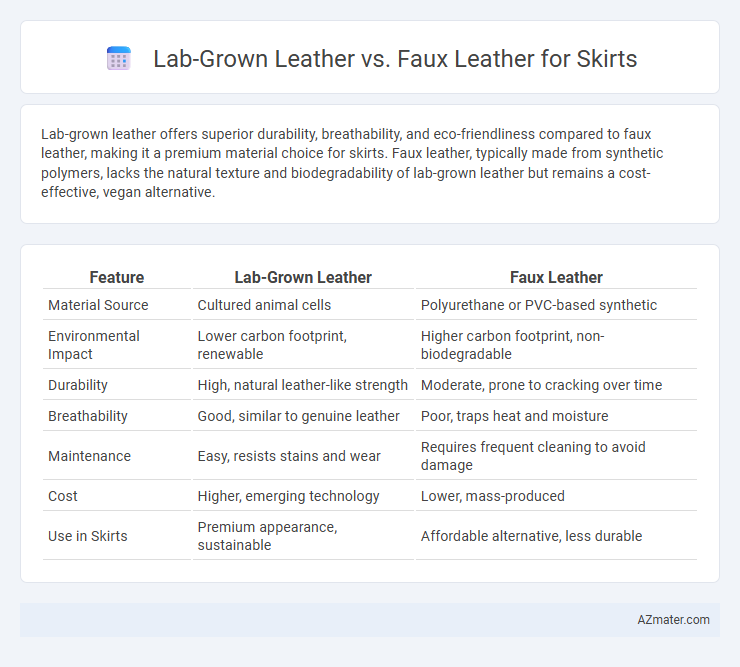Lab-grown leather offers superior durability, breathability, and eco-friendliness compared to faux leather, making it a premium material choice for skirts. Faux leather, typically made from synthetic polymers, lacks the natural texture and biodegradability of lab-grown leather but remains a cost-effective, vegan alternative.
Table of Comparison
| Feature | Lab-Grown Leather | Faux Leather |
|---|---|---|
| Material Source | Cultured animal cells | Polyurethane or PVC-based synthetic |
| Environmental Impact | Lower carbon footprint, renewable | Higher carbon footprint, non-biodegradable |
| Durability | High, natural leather-like strength | Moderate, prone to cracking over time |
| Breathability | Good, similar to genuine leather | Poor, traps heat and moisture |
| Maintenance | Easy, resists stains and wear | Requires frequent cleaning to avoid damage |
| Cost | Higher, emerging technology | Lower, mass-produced |
| Use in Skirts | Premium appearance, sustainable | Affordable alternative, less durable |
Introduction: The Rise of Alternative Leathers in Fashion
Lab-grown leather, created through cellular agriculture, offers a sustainable and cruelty-free alternative to traditional animal leather, making it increasingly popular for eco-conscious fashion items like skirts. Faux leather, typically made from polyurethane or PVC, provides an affordable and versatile option but often falls short in environmental impact due to its synthetic production. The rise of these alternative leathers reflects growing consumer demand for ethical, sustainable materials in the fashion industry.
What is Lab-Grown Leather?
Lab-grown leather, also known as cultured or bio-fabricated leather, is produced by cultivating animal cells in a controlled environment to create real leather without raising or slaughtering animals. Unlike faux leather, which is typically made from synthetic materials like polyurethane or PVC, lab-grown leather offers the authentic texture, durability, and breathability of traditional leather with a significantly lower environmental impact. This innovative process reduces resource consumption, greenhouse gas emissions, and waste, making lab-grown leather a sustainable alternative for fashion items such as skirts.
Understanding Faux Leather: Materials and Manufacturing
Faux leather, commonly made from polyurethane (PU) or polyvinyl chloride (PVC), simulates the appearance of genuine leather through synthetic materials engineered for durability and water resistance. The manufacturing process involves coating a fabric base with plastic polymers, creating a flexible, leather-like surface that is cost-effective and cruelty-free. This material's adaptability allows for varied textures and finishes, making it a popular choice for skirts demanding both style and ethical considerations.
Environmental Impact: Lab-Grown Leather vs Faux Leather
Lab-grown leather significantly reduces environmental impact by utilizing cellular agriculture techniques that minimize water usage and greenhouse gas emissions compared to traditional animal farming methods. Faux leather, primarily made from synthetic materials like polyurethane or PVC, involves petrochemical processes that contribute to pollution and generate non-biodegradable waste. Choosing lab-grown leather for skirts promotes sustainability by offering a biodegradable alternative with lower carbon footprints than faux leather alternatives.
Durability and Longevity in Skirts
Lab-grown leather offers enhanced durability and longevity for skirts due to its bio-engineered collagen fibers that mimic natural leather's strength, resisting wear and tear more effectively than traditional faux leather. Faux leather, typically made from polyurethane or PVC, tends to degrade faster, showing cracks and peeling with prolonged use and exposure to heat and moisture. Skirts crafted from lab-grown leather maintain their texture and structural integrity longer, making them a superior investment for long-lasting fashion.
Texture, Look, and Feel: Aesthetic Differences
Lab-grown leather exhibits a natural grain texture and subtle variations that closely mimic genuine leather, offering a more authentic and luxurious appearance compared to faux leather. Faux leather typically has a uniform, synthetic surface that can appear glossy or plasticky, lacking the depth and tactile richness of lab-grown alternatives. The feel of lab-grown leather is softer and more supple, providing enhanced comfort and flexibility, whereas faux leather often feels stiffer and less breathable, impacting its overall aesthetic appeal for skirts.
Comfort and Wearability for Skirts
Lab-grown leather offers superior breathability and flexibility compared to faux leather, providing enhanced comfort for skirts worn over long periods. Its natural texture allows better moisture absorption, reducing skin irritation and improving wearability in various climates. Faux leather tends to be stiffer and less breathable, which can cause discomfort and limit ease of movement in skirt designs.
Cost Comparison: Affordability and Value
Lab-grown leather skirts generally have a higher upfront cost compared to faux leather due to advanced production technologies and sustainable materials involved. Faux leather offers a more affordable option, making it accessible for budget-conscious consumers without compromising style. However, lab-grown leather provides greater durability and environmental benefits, potentially offering better long-term value despite the initial investment.
Ethical Considerations in Material Choices
Lab-grown leather offers a sustainable alternative to traditional leather by reducing animal cruelty and minimizing environmental impact through biotechnological processes. Faux leather, typically made from synthetic materials like polyurethane or PVC, avoids animal products but often involves non-biodegradable chemicals and fossil fuel usage. Choosing lab-grown leather for skirts supports ethical fashion by promoting cruelty-free production and lowering carbon footprint compared to conventional faux leather options.
Choosing the Right Leather Alternative for Your Skirt
Lab-grown leather offers a sustainable and biodegradable option for skirts, providing the authentic texture and durability of genuine leather without animal cruelty. Faux leather, typically made from polyurethane or PVC, is more affordable and widely available but can lack breathability and environmental friendliness. When choosing the right leather alternative for your skirt, consider factors like ecological impact, comfort, longevity, and the intended style to ensure the material aligns with your ethical values and fashion needs.

Infographic: Lab-grown leather vs Faux leather for Skirt
 azmater.com
azmater.com